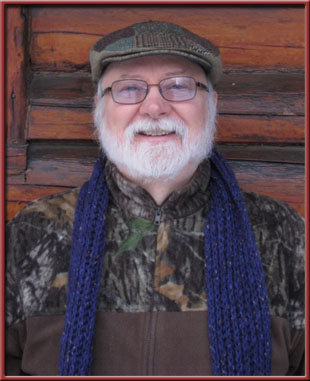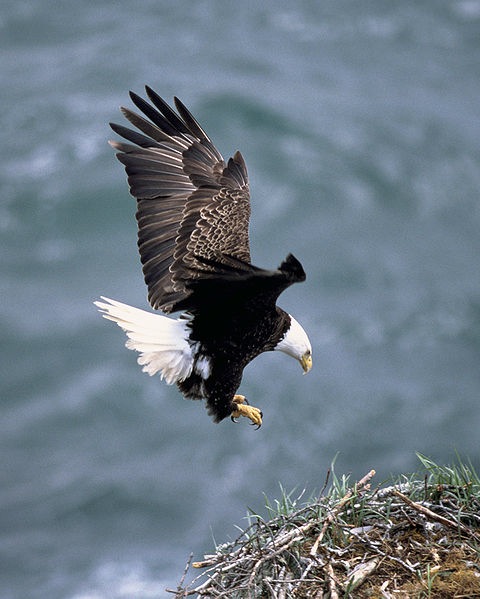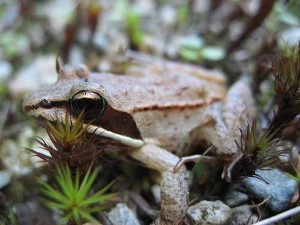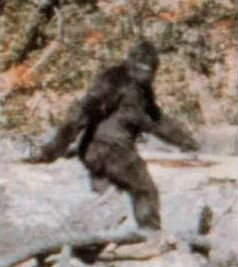The Great Alaskan Bizarre: Of Palins, Bigfeet & Wood Frogs
Above The Timberline
by Wayne Mergler

ANCHORAGE, AK—(Weekly Hubris)—8/30/10—I am afraid it has become nearly a cliché by now, but it is true nonetheless: Alaska is simply not like other places.
There are at least a dozen potential columns in just that deliberately broad statement, alone. Most people who come up here, particularly those who stay for a winter, soon discover for themselves that they are in a place so unusual that many people would neither believe it nor ever imagine it. They are thousands of miles away from wherever they came from, no matter where that is but, in truth, they might just as well be on the moon. Alaska is another world entirely.
Some of its bizarre differences are well touted.
Alaska is a place of extremes and it takes extreme people to live here. It is not just beautiful here; it is BEAUTIFUL! It is not just cold here; it is COLD! The extremes of weather and scenery are well documented by now. You’d have to live in a cave somewhere (outside of Alaska) not to know this. And the very act of being alive here is extreme, too.
A couple of books have been written on the bizarre lifestyles of Alaskans; notably the many weird and fantastic ways to die here. Alaskans tend not to die of heart attacks and cancer and car accidents (though, of course, we do have those hazards); it is much more likely that, if you are an Alaskan, you will meet your demise in some more extreme way: an earthquake, avalanche, quicksand, forest fire, flood, or volcanic eruption could take you out at any minute.
And then, of course, there are all the wild animals—bears, wolves, wolverines, moose, lynxes, even wild dogs and feral cats—that are often hostile to man. You could easily freeze to death. Or, at the very least, you could lose a number of fingers and toes and an occasional nose from severe frostbite. Some have even been driven insane (literally), while hiking through bogs and flats and woods, by armies of attacking mosquitoes. And the murder rate is high here. Some folks go a little nuts near the end of the very long and dark winters and take it out on neighbors or spouses or even friends.
My wife and I witnessed, during our first winter here, a real honest-to-God shoot-out, like they used to have in Dodge City, right on our own street in an Anchorage neighborhood. A husband, crouched behind his parked car on the street, fired a handgun repeatedly at his wife who, from their apartment window across the street, fired her handgun back at him. (She even dramatically broke the window glass with the barrel of her gun, just like in the movies!)
And your pets aren’t immune to the mayhem, either. Several incidents of small, yipping dogs snatched by eagles and carried up into the mountain eyries have been reported, usually while hysterical pet owners watch in horror. One tourist, understandably distraught, called the state troopers and screamed over the phone that her precious chihuahua had been scooped up by an eagle as she was let out of the SUV to do her business. The woman demanded that the troopers “do something!”

“Lady, I’m sorry,” said the trooper, with the usual Alaskan tact and sensitivity, “but I’m afraid your chihuahua is now lunch.”
In fact, life in Alaska is so bizarre that fortunes have been made simply chronicling it.
Anchorage’s bookstores alone have enormous sections containing “local interest” or “Alaskana,” books after books that try to explain and inform about this place. A tourist recently said to me, “I can’t believe how many books there are about Alaska! I’m from Iowa. In our bookstores, the Iowa section is really tiny.” When you consider that Iowa and Virginia and Texas and all those other places have much longer histories than Alaska has—at least mainstream, non-Native history, that is—it does seem remarkable that Alaska has engendered so many fascinating books.
And the chronicling isn’t just done in books. For many years, a local Anchorage celebrity called Mr. Whitekeys performed in a midtown bar, to great acclaim, celebrating in music, poetry, and comedy skits the absolutely wacko world of Alaskans. Mr. Whitekeys has retired now, a great loss to his many fans in Anchorage, though the state’s bizarre behavior and lifestyles continue, unabated if unsung.
All anyone really has to do is follow the many misadventures and outrageous doings of Sarah Palin and her clan, along with Levi Johnston, to get an inkling. And I’m here to tell you: the Palins are not the strangest or the most colorful Alaskans up here. They are just, right now, the best known to the rest of the world.
We live in a place where we see moose and bear nearly every time we leave our house, where we hear the singing of wolves on deep winter nights, where the Aurora Borealis (northern lights) dazzle in the sky regularly, and where the highest mountain peaks in North America stretch up into the sky. Sunsets are spectacular, particularly in the winter, when it is really cold: the entire western sky looks as though it is on fire.
The city of Anchorage is home to 200 wild moose, 60 bears, and 30 wolves, according to the most recent reports, all meandering in and around a bustling modern city. Every year, when my kids were growing up, we would drive a few miles down the southbound highway leaving Anchorage to a place called Beluga Point. There we would sit on the rocks at the edge of the water and watch the belugas come up in late May and then go out again in late August or early September. Sometimes, the wonderful, smiling-faced white whales would surface, often with their young surfacing in perfect synchronicity with them, so close that we could feel the steam from their bodies and smell their fishy breath. My children would clap their hands in delight, loving the sea spray that splashed over them, loving the wonderful mammals of the sea. In late summer we would walk along the boardwalks at nearby Potter Marsh and watch the salmon struggling up to their spawning grounds. Trumpeter swans, sea birds of all types, and the occasional fishing bear would sometimes be there, too.
But stories about moose and bears and wolves, spawning salmon, marauding eagles and migrating whales are not so very remarkable anymore. But there are creatures here less well known and, in some ways, infinitely more fascinating because of it. Take, for instance, the wood frog. Some people are surprised to learn that we have any frogs in Alaska at all. In fact, we have five amphibians that dwell in the Frozen North: the spotted frog, the boreal toad, the long-toed salamander, the rough-skinned newt and, the most wonderful of all, the wood frog.

The wood frog is very Alaskan in its uniqueness and in the extremeness of its being. It is found in nearly all parts of Alaska and it has a most unique and wonderful way of surviving the cold: it survives by freezing. Every winter, when the temperatures drop and the snow flies, the wood frog freezes up as solid as a chunk of ice. To human eyes, it appears as dead as a plucked chicken in a deep freeze. But in the spring, it miraculously comes back to life, apparently unfazed by its long state of suspended animation. This occurs, apparently, because ice forms in spaces between its cells, rather than in the cells, themselves, thus not damaging the cells but protecting them.
My daughter Joanna and I put this to the test one winter many years ago.
Joanna and I were out on a winter’s walk. She was about five or six at the time. And as we dug into the muskeg and tundra, looking for frozen-over berries—remarkable in themselves: crystallized berries beneath thin layers of ice—we came upon a frozen solid and obviously dead little frog.
“I think it’s a wood frog,” I told her. The wood frog is distinctive looking, with a dark eye mask and a stripe running down its back.
Joanna was distressed that it had frozen to death in the snow.
“I’m quite sure it’s not dead,” I told her. My biology teacher friend at the school where I taught had educated me about the wood frog.
So, we took the frozen frog home, placed it in a shoe box with some leaves and brown grass and left it overnight in the kitchen. The next day we had a tiny frog jumping all over our kitchen floor, much to Joanna’s delight. After letting it hop about for awhile, we put it back outside, to freeze up again for another long nap until spring.
Other wonders here are the enormous vegetables grown in the summer months. Most famous are the cabbages, which have grown to the size of Volkswagen beetles. Farmers from Alaska’s Matanuska Valley are proud to show their humongous vegetables every year at the Alaska State Fair in Palmer in late August and early September. Some of the largest recorded vegetables in recent years have been a 98-pound cabbage, an 18-pound carrot, and a 347-pound pumpkin. I have also seen strawberries the size of tomatoes and squashes that weighed a dozen pounds. The reason for this magic is the never-ending sunlight of the Alaskan summer. With the sun beaming down 24/7 for much of the summer, the vegetables just grow and grow.
Alaska is also, as you might guess, host to a number of sightings of the very strange and the seemingly impossible. Enormous fish or sea creatures have been spotted in Alaska’s rivers and lakes and coastal areas. Most dramatic is the great sturgeon, a fish that can grow to enormous lengths if not caught by a fisherman’s net or hook early in its life. Early travelers along the Yukon River used to spot giant serpent-like creatures occasionally rising from the silt of the river. It is believed that these were sturgeons, grown to massive sizes.
And, of course, the most dramatic and fascinating of all Alaska’s wonders might well be our own answer to Bigfoot.

The Natives call him the hairy man or the woodsman, and he is as real to them as a deer or a fox to many Americans. Some say he is a Sasquatch; others say that he is a creature who was once a man, but has lived in total isolation for so long that he has evolved, Gollum-like, into something else. Some describe him as big and hairy, ape-like, leaving enormous footprints in the snow; others say that he is no bigger than a normal-sized man, though he is far stronger and tougher.
The most eloquent and brilliant assessment of the Alaskan woodsman comes from respected and prolific anthropologist, Richard K. Nelson, whose wonderful book, Make Prayers to the Raven: A Koyukon View of the Northern Forest (University of Chicago Press, 1983) includes an entire chapter on this creature. I have never met an Alaskan Native, raised in the Bush, who did not have a story to tell about the woodsman. One woman told me that her little sister was kidnapped by a woodsman, who tore the door off their house to snatch her away. Hunters often have stories about encounters with woodsmen. There is a legendary valley in Alaska’s vast interior that supposedly has had a number of sightings of this elusive and terrifying creature. Some mysterious deaths have even been attributed to him. I even have my own woodsman story, though it pales by comparison to the other stories that abound.
Many years ago, when my wife Maureen and I were in our early 20’s and newly arrived in Alaska, we attended the annual Anchorage Fur Rendezvous, a kind of winter carnival, Alaska’s answer to Mardi Gras and, of course, went to the popular and lavish fur auction that gives the celebration its name.
Trappers and hunters come in from all over Alaska, just like the traditional trappers and mountain men used to do, bringing in their pelts and furs and other items to sell or to trade. Alaska is probably the only place left on the planet where fur is not politically incorrect. Some spectacular furs may be seen at the Fur Rondy Auction.
That first winter in Alaska, as Maureen and I stood in the crowd, watching the hawking of the furs with great interest, an old sourdough came up to us and began to chat. He was about 70 years old or so I thought. It’s hard to tell with these old trappers and hunters; their lives have been rugged and amazing. He may actually have been 35. Who knows? But he was dressed in a variety of winter furs, including a large hat made from the head of a wolf, worn so that the wolf’s face looked out at you over the man’s.
Under his arm he carried a rolled up rug-like bundle, which he wanted to show us. He then unraveled the ugliest, rattiest looking old pelt that I have ever seen. It looked very much like the skin of a black bear, except that the fur was much thinner than a bear’s, and longer. It grew in tufts and patches, as though the creature had suffered from mange. Gray hairs mixed prodigiously with the black. It smelled of a heady mixture of stale feces and wild animal. Maureen wrinkled her nose and stepped back.
“That is the ugliest-looking fur I’ve ever seen,” I told him. “You aren’t expecting to sell that, are you?”
“Oh, I’ll sell it all right,” he said, enigmatically. “I’ll make my fortune on this one.”
“What is it?” I asked him then, fully expecting him to admit that he had killed and skinned an ancient, molting bear.
He grinned and I remember noticing that he had amazingly white and even teeth for an old sourdough who lived in the woods somewhere.
“It’s a Woodsman,” he told me. “A hairy man.”
He stretched it out; it was no longer than a tallish man. It was too thin to be a bear. Or so it seemed to me.
At that time I was unfamiliar with those names. It took me some time to realize that what the old timer was describing was something akin to a sasquatch. By that time, a small crowd had gathered around the old trapper. One gentleman, a Korean furrier, invited him to bring his pelt to the furrier’s shop, where he could investigate it more thoroughly.
“Do you believe what he says?” one guy in the crowd asked the Korean.
“It is very interesting,” said the furrier. “It is not anything I can identify at the moment.”
And so the Korean furrier and the old trapper rolled up the ratty pelt and walked away together. I wish now that I had gone with them. I have often wondered what became of that pelt. I certainly never saw any newspaper articles about Bigfoot’s skin having shown up at the Fur Rendezvous Auction. But even if there had been such a write-up, it might easily have been overlooked among the other bizarre, weird and unbelievable news of the day (any day) in Alaska.